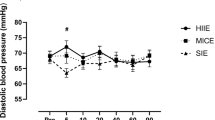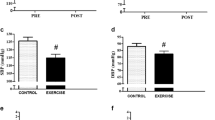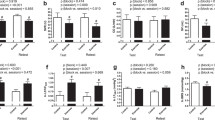Abstract
Our purpose was to examine whether the transient suppression of blood pressure that occurs during the hours following acute exercise (termed post exercise hypotension) persists throughout an active period of subsequent mild exercise and simulated activities of daily living (ADL) using direct measurements of arterial pressure. Eight recreationally active participants, with low borderline systolic hypertension completed 30 min of cycle ergometry at 70% VO2Peak and 30 min of quiet seated rest on separate days (randomised order). Following exercise and rest, subjects completed a 70-min protocol of mild exercise and simulated ADL. Blood pressure was monitored throughout by catheterisation of the radial artery. Exercise resulted in lower systolic (SBP), diastolic (DBP) and mean arterial pressure (MAP) throughout the post exercise ADL period compared to control measurements taken without prior exercise. The maximal difference in SBP, DBP and MAP between trials was 26, 7 and 13 mm Hg respectively. Average differences in SBP, DBP and MAP between trials were 16, 5 and 8 mm Hg respectively. This relative hypotension occurred in spite of higher heart rates during the ADL measurement period following the prior exercise. Furthermore, many of the blood pressure measurements during the post exercise period were significantly lower than the pre-exercise values during the same trial. We conclude that post exercise hypotension persists during mild exercise and simulated ADL. Although the duration of this relative hypotension needs to be determined, acute exercise may serve as a non-pharmacological aid in the treatment of hypertension.
This is a preview of subscription content, access via your institution
Access options
Subscribe to this journal
Receive 12 digital issues and online access to articles
$119.00 per year
only $9.92 per issue
Buy this article
- Purchase on Springer Link
- Instant access to full article PDF
Prices may be subject to local taxes which are calculated during checkout
Similar content being viewed by others
References
Franklin PJ, Green DJ, Cable NT The influence of thermoregulatory mechanisms on post-exercise hypotension in humans J Physiol 1993 470 231–241
Piepoli M et alPersistent peripheral vasodilation and sympathetic activity in hypotension after maximal exercise J Appl Physiol 1993 75 1807–1814
Boone JB, Jr, Probst MM, Rogers MW, Berger R Postexercise hypotension reduces cardiovascular responses to stress J Hypertens 1993 11 449–453
Floras JS et alPostexercise hypotension and sympathoinhibition in borderline hypertensive men Hypertension 1989 14 28–35
Cleroux J et alAftereffects of exercise on regional and systemic hemodynamics in hypertension Hypertension 1992 19 183–191
MacDonald JR et alHypotension following mild bouts of resistance exercise and submaximal dynamic exercise Eur J Appl Physiol 1999 79 148–154
Pescatello LS, Fargo AE, Leach CN, Jr, Scherzer HH. Short-term effect of dynamic exercise on arterial blood pressure Circulation 1991 83 1557–1561
Brownley K, West S, Hinderliter A, Light K Acute aerobic exercise reduces ambulatory blood pressure in borderline hypertensive men and women Am J Hypertens 1996 9 200–206
Reukert P, Slane P, Lillis P, Hanson P Hemodynamic patterns and duration of post-dynamic exercise hypotension in hypertensive humans Med Sci Sports and Exercise 1996 28 24–32
Wallace JP et alThe magnitude and duration of ambulatory blood pressure reduction following acute exercise J Hum Hypertens 1999 13 361–366
Somers VK et alPostexercise hypotension is not sustained in normal and hypertensive humans Hypertension 1991 18 211–215
Hara K, Floras JS Influence of naloxone on muscle sympathetic nerve activity, systemic and calf haemodynamics and ambulatory blood pressure after exercise in mild essential hypertension J Hypertens 1995 13 147–461
Kamath MV, Fallen EL Power spectral analysis: a noninvasive signature of cardiac autonomic function Crit Rev Biomed Eng 1993 21 245–311
Pagani M et alLow and high frequency components of blood pressure variability Ann NY Acad Sci 1996 783 10–23
Hannum SM, Kasch FW Acute postexercise blood pressure response of hypertensive and normotensive men Scand J Sport Sci 1981 3 11–15
Acknowledgements
This study was supported by the Natural Sciences and Engineering Research Council, Canada.
Author information
Authors and Affiliations
Corresponding author
Rights and permissions
About this article
Cite this article
MacDonald, J., Hogben, C., Tarnopolsky, M. et al. Post exercise hypotension is sustained during subsequent bouts of mild exercise and simulated activities of daily living. J Hum Hypertens 15, 567–571 (2001). https://doi.org/10.1038/sj.jhh.1001223
Received:
Revised:
Accepted:
Published:
Issue Date:
DOI: https://doi.org/10.1038/sj.jhh.1001223
Keywords
This article is cited by
-
High-intensity interval exercise promotes post-exercise hypotension of greater magnitude compared to moderate-intensity continuous exercise
European Journal of Applied Physiology (2019)
-
Cardiovascular and hemodynamic responses to adapted physical exercises in very old adults
Aging Clinical and Experimental Research (2017)
-
Exercise for Hypertension: A Prescription Update Integrating Existing Recommendations with Emerging Research
Current Hypertension Reports (2015)
-
The higher exercise intensity and the presence of allele I of ACE gene elicit a higher post-exercise blood pressure reduction and nitric oxide release in elderly women: an experimental study
BMC Cardiovascular Disorders (2011)
-
Acute resistance exercise reduces blood pressure and vascular reactivity, and increases endothelium-dependent relaxation in spontaneously hypertensive rats
European Journal of Applied Physiology (2010)



